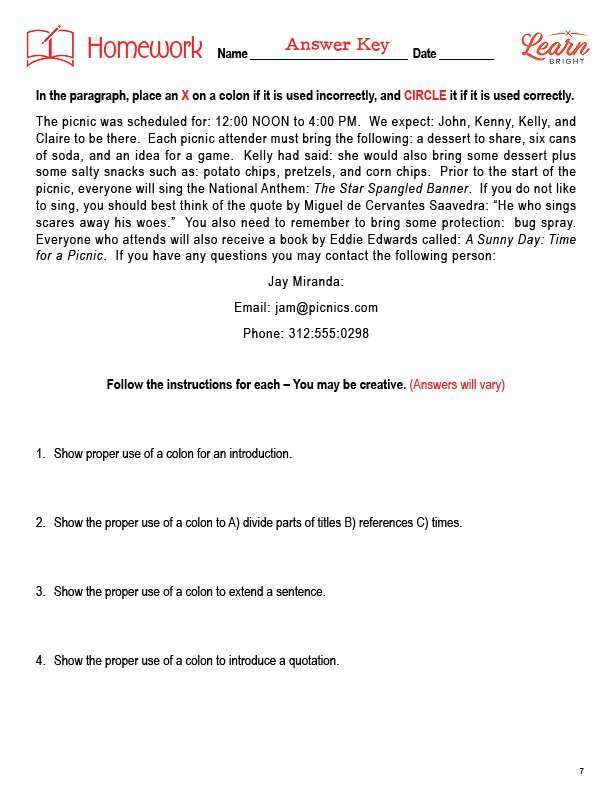Description
What our Colons lesson plan includes
Lesson Objectives and Overview: Colons enhances students’ writing skills as they identify a colon and learn how to use colons correctly in their writing. This lesson is for students in 6th grade.
Classroom Procedure
Every lesson plan provides you with a classroom procedure page that outlines a step-by-step guide to follow. You do not have to follow the guide exactly. The guide helps you organize the lesson and details when to hand out worksheets. It also lists information in the yellow box that you might find useful. You will find the lesson objectives, state standards, and number of class sessions the lesson should take to complete in this area. In addition, it describes the supplies you will need as well as what and how you need to prepare beforehand. The supplies you will need for this lesson are black circles or dots and the handouts. To prepare for this lesson ahead of time, you can copy the handouts and cut out enough black dots for each student to have two.
Options for Lesson
Included with this lesson is an “Options for Lesson” section that lists a number of suggestions for activities to add to the lesson or substitutions for the ones already in the lesson. As a lesson adjustment, you can have students complete the practice page as a homework assignment. You can also find additional resources for further practice. If you’d like, you could combine this lesson with lessons on semi-colons, commas, or other punctuation marks.
Teacher Notes
The teacher notes page includes a paragraph with additional guidelines and things to think about as you begin to plan your lesson. It notes that it might be a good idea to combine this lesson with other lessons on different kinds of punctuation. This page also includes lines that you can use to add your own notes as you’re preparing for this lesson.
COLONS LESSON PLAN CONTENT PAGES
Colons
The Colons lesson plan includes one page of content. The lesson begins by defining colons as a punctuation mark that serves multiple purposes. We use colons in introductions, to expand on an idea already mentioned in a sentence, in references for books or title, to show time, and with quotations. The lesson describes each of these uses further and provides several examples of each use.
Firstly, we use colons for introductions. The words to the left of the colon introduce what’s to the right of the colon. Secondly, we use colons to divide parts of titles, references, and times. Thirdly, we use them to extend sentences. In these cases, the information on the left equals the information on the right. Finally, we use them to introduce quotations (though this is optional, and not all quotes are introduced with colons). When you see the words “the following,” you can usually expect a colon to follow, used before a list of items.
The more you use colons, the better you will understand the rules. It’s important to remember not to overuse colons in your writing, however. Sometimes, you can use a comma or semi-colon instead.
COLONS LESSON PLAN WORKSHEETS
The Colons lesson plan includes two worksheets: a practice worksheet and a homework assignment. You can refer to the guide on the classroom procedure page to determine when to hand out each worksheet.
CORRECTLY PLACE COLONS PRACTICE WORKSHEET
For the practice worksheet, students will complete two short exercises. The first asks them to read a paragraph and correctly add colons where they are needed. The second asks them to answer specific questions related to the lesson (for example, “Show proper use of a colon for an introduction”).
Students can work in pairs to complete this practice if you’d prefer.
COLONS HOMEWORK ASSIGNMENT
Similarly to the practice worksheet, the homework assignment asks students to complete two exercises: one where they read a paragraph and place an X over incorrect colons and circle correct colons, and one where they answer specific questions related to the lesson material.
Worksheet Answer Keys
This lesson plan includes answer keys for the practice worksheet and the homework assignment. If you choose to administer the lesson pages to your students via PDF, you will need to save a new file that omits these pages. Otherwise, you can simply print out the applicable pages and keep these as reference for yourself when grading assignments.









